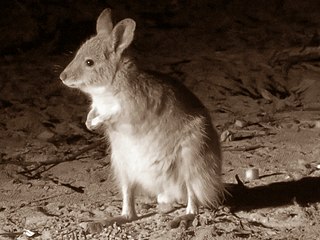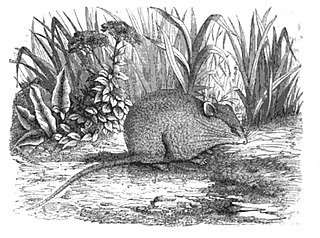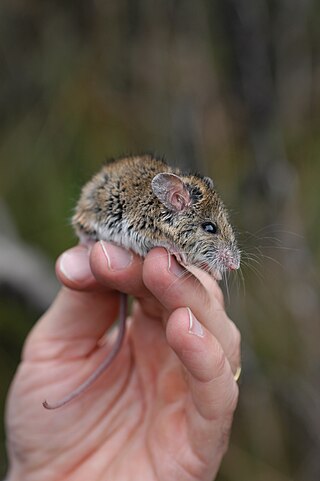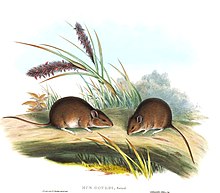
The banded hare-wallaby, mernine, or munning is a marsupial currently found on the islands of Bernier and Dorre off western Australia. Reintroduced populations have recently been established on islands and fenced mainland sites, including Faure Island and Wadderin Sanctuary near Narembeen in the central wheatbelt.

Pseudomys is a genus of rodent that contains a wide variety of mice native to Australia and New Guinea. They are among the few terrestrial placental mammals that colonised Australia without human intervention.

Threatened fauna of Australia are those species and subspecies of birds, fish, frogs, insects, mammals, molluscs, crustaceans, and reptiles to be found in Australia that are in danger of becoming extinct. This article lists species classified as threatened species under the Commonwealth Environment Protection and Biodiversity Conservation Act 1999.

The Western barred bandicoot, also known as the Shark Bay bandicoot or the Marl, is a small species of bandicoot; now extinct across most of its former range, the western barred bandicoot only survives on offshore islands and in fenced sanctuaries on the mainland.

The rufous hare-wallaby, also known as the mala, is a small macropod found in Australia. It was formerly widely distributed across the western half of the continent, but naturally occurring populations are now confined to Bernier Island and Dorre Island Islands off Western Australia.

The heath mouse is a species of mouse in the subfamily Murinae, the Old World rats and mice, found in Australia.

Yalgoo is an interim Australian bioregion located in Western Australia. It has an area of 5,087,577 hectares. The bioregion, together with the Avon Wheatbelt and Geraldton Sandplains bioregions, is part of the larger Southwest Australia savanna ecoregion as classified by the World Wildlife Fund.

The plains rat(Pseudomys australis), also known as the palyoora, plains mouse and eastern mouse, is a conilurine rodent native to arid and semi-arid Australia. Referred to as the pallyoora or yarlie by Indigenous groups, the plains rat was once widely distributed across central Australia, including north-west New South Wales and south-west Queensland; however, habitat degradation due to grazing, introduced predators and drought have contributed to its decline. Consequently, the plains rat has been listed as 'presumed extinct' in New South Wales and Victoria, 'endangered' in the Northern Territory and Queensland and 'vulnerable' in Western Australia and South Australia. While recent research has indicated the presence of the plains rat in areas such as the Fowlers Gap and Strzelecki Desert regions of New South Wales and within the Diamantina National Park in Queensland, there are only five sub-populations currently recognised nationally, none of which coincide with recent discoveries of the plains rat. As the current population trend of the plains rat has been listed as 'declining' by the International Union for the Conservation of Nature (IUCN), the IUCN conservation status for the species is 'vulnerable'.

The greater stick-nest rat, also known as the housebuilding rat and wopilkara, is a species of rodent in the family Muridae. They are about the size of a small rabbit and construct large nests of interwoven sticks. Once widespread across southern Australia, the population was reduced after European colonisation to a remnant outpost on South Australia's Franklin Islands. The species has since been reintroduced to a series of protected and monitored areas, with varying levels of success.

The ash-grey mouse is a rodent in the family Muridae. Larger and more robust than Mus musculus, the common house mouse, it is found only in Southwest Australia.

The smoky mouse is a species of rodent in the family Muridae native to southeastern Australia. It was first described in 1934 and its species name is Latin for "smoky". As its name suggests, it is a grey-furred mouse, darker grey above and paler smoky grey below. Mice from the Grampians are larger and a darker more slate-grey above. It has a black eye-ring and dark grey muzzle. The feet are light pink, and the ears a grey-pink. The tail is longer than the mouse's body, and is pink with a brownish stripe along the top. Mice from east of Melbourne average around 35 grams and have 107 mm long bodies with 116 mm long tails, while those from the Grampians are around 65 grams and have 122 mm long bodies with 132 mm long tails.
The blue-gray mouse is an Australian rodent species that is only known by a few specimens found in Eastern Australia, and since presumed to have become extinct.

The New Holland mouse also known as a Pookila is a species of rodent in the family Muridae. It was first described by George Waterhouse in 1843. It vanished from view for over a century before its rediscovery in Ku-ring-gai Chase National Park north of Sydney in 1967. It is found only in south east Australia, within the states of New South Wales, Queensland, Victoria, and Tasmania.

The western mouse or walyadji is a species of rodent in the family Muridae. Once widespread across a larger range, it has become restricted to around ten reserves of remnant bushland in Southwest Australia and declared near threatened by extinction. They are small and robust mice that live in burrows in sandy soil, venturing out at night to forage in nearby area.

Pseudomys pilligaensis, commonly known as the Pilliga mouse or poolkoo, is a species of rodent in the family Muridae. Its distribution comprises the Pilliga forest region of New South Wales, Australia, specimens have also been trapped in the Warrumbungle National Park and Weetalibah Nature Reserve. Its conservation status is currently listed as "Data Deficient" due to unresolved questions on its taxonomic status.

Bernier Island is one of three islands that comprise the Bernier and Dorre Island Nature Reserve in the Shark Bay World Heritage area in Western Australia.
Pebble-mound mice are a group of rodents from Australia in the genus Pseudomys. They are small, brownish mice with medium to long, often pinkish brown tails. Unlike some other species of Pseudomys, they construct mounds of pebbles around their burrows, which play an important role in their social life.

Hydromyini is a very large, diverse tribe of muroid rodents in the subfamily Murinae. They are the dominant native rodents in Australasia and one of only two native rodent groups there, the other being the R. fuscipes group of the genus Rattus in the tribe Rattini. They are also found in parts of Southeast Asia.

















